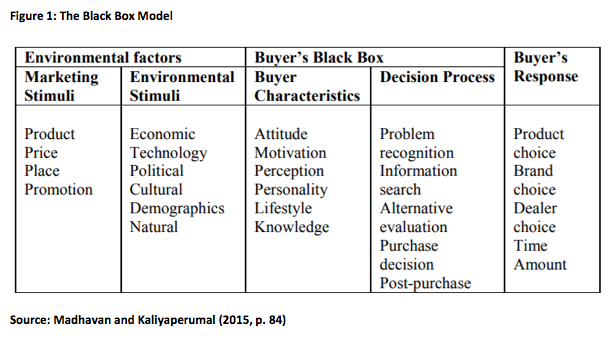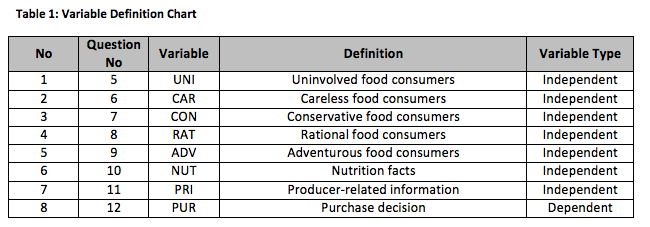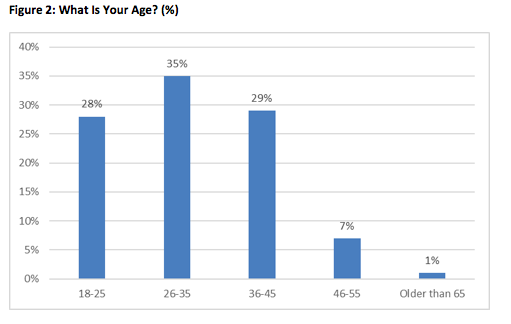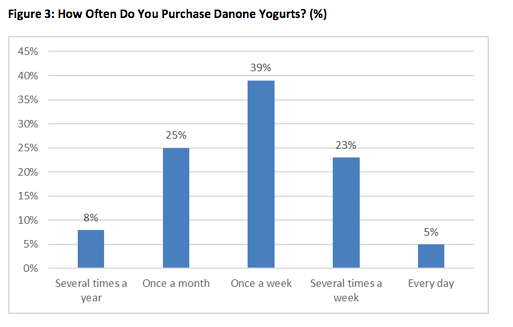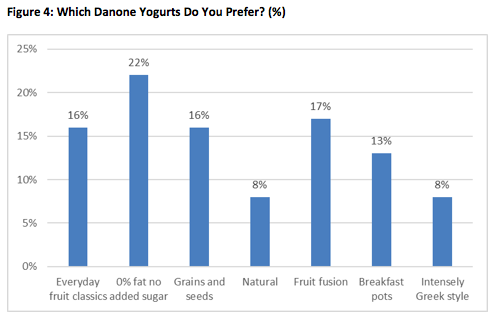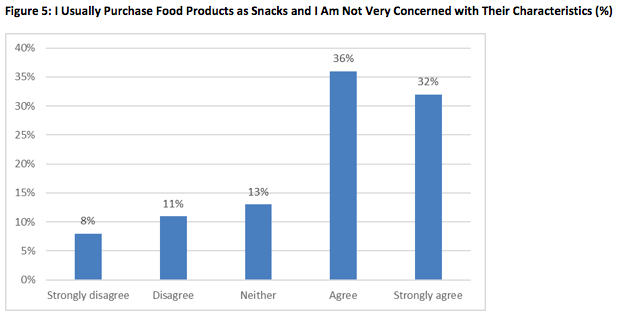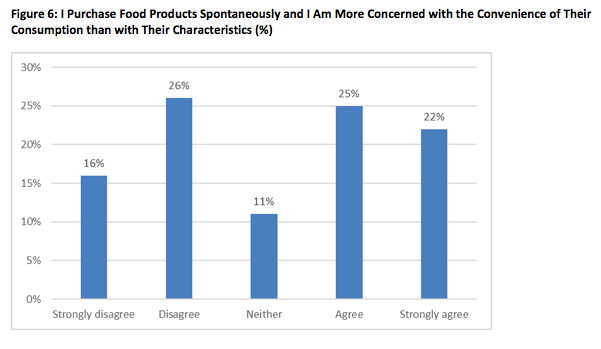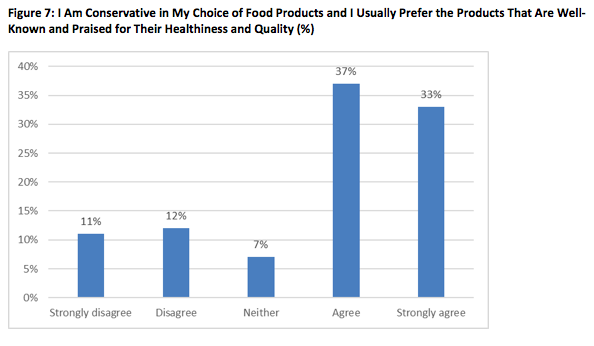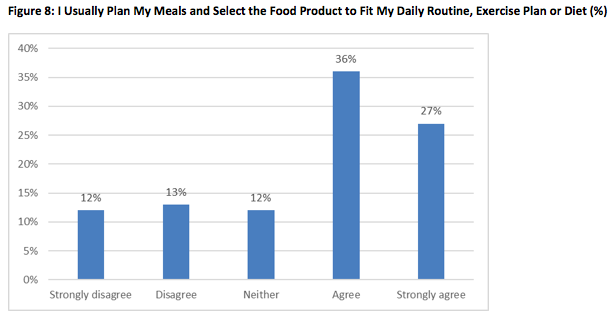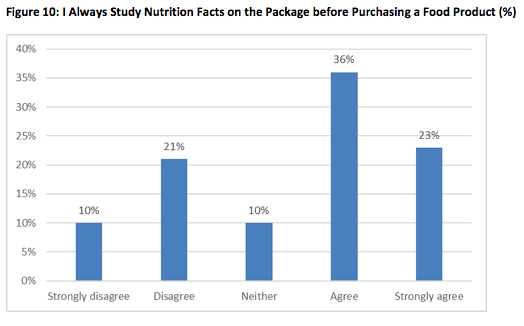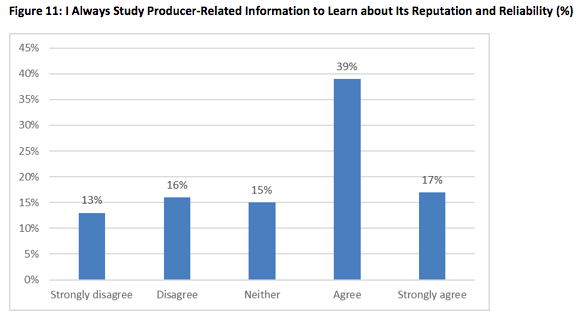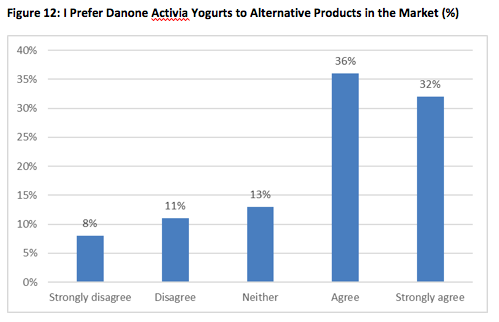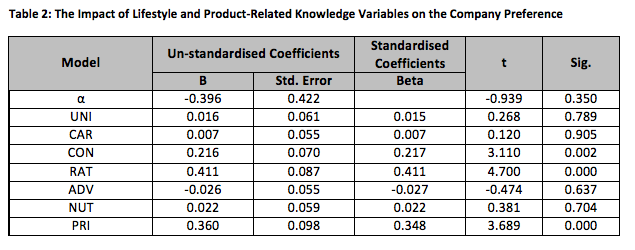Written by Jess C.
Abstract
This dissertation analysed the impact of customers’ behavioural lifestyles and product-related knowledge on the individual purchase decisions of Danone Activia yogurts in the UK. The data was collected from 100 respondents who bought Danone’s products in the past. The quantitative survey revealed their product preferences, preferred lifestyle-related behaviours and product-related knowledge factors to determine the decision-making process. It was identified that conservative and rational food consumption patterns as well as producer-related information had a statistically significant effect on the intention to buy Danone Activia yogurts. That said, 92% of the sample were formed by the respondents from the 18-45 age segment, which could limit the generalisability of the findings to the whole UK population.
Chapter 1: Introduction
1.1. Problem Statement
The open nature of modern communication and information transfer substantially increases the number of factors influencing customer purchase behaviours (Khaniwale, 2015). Buyers in the market are influenced by a large number of external and internal stimuli that determine their attitudes towards brands and products. This substantially complicates segmentation, targeting and positioning activities for marketers, as they have to make their products attractive to the majority of prospective customers through achieving compliance with their unique lifestyles and buying preferences (Ahmed et al., 2015). This problem substantiates the necessity to use specialised analysis instruments and frameworks to identify the unique correlations between customer characteristics and positive purchase decisions.
1.2. Rationale for the Research
Customer decision-making is a highly complex process that is difficult to study because a large part of it is influenced by internal mechanisms defined by culture, individual experiences and other elements that are not visible to marketers (Karimi and Pirasteh, 2015). These factors are studied by such models as the black box model. This framework analyses the activities of marketers and conversion results and then attempts to identify all internal and external factors that influence the purchase intentions of consumers (Kotler and Armstrong, 2015). However, such analysis requires an extensive knowledge of the targeted customer segment because consumer behaviours may be influenced by such enculturated individuality factors as lifestyle choices or existing product-related knowledge (Kanagal, 2016). These two elements are especially important within the scope of the food industry because consumers are often guided by their attitudes towards sports-related activities, diets or healthiness concerns in their evaluation of food products.
1.3. Research Background
The studies of Al-Dmour et al. (2017) and Vaidya (2015) identified that customer lifestyle-related behaviours had a significant impact on consumers’ purchase intentions. It was established that the degree of fit between the offered goods and services and the behaviours typical of the respondents was critical for achieving positive promotion results and loyalty. However, these studies were not focused on the industry analysed in this dissertation. At the same time, Arunadevi (2016) and Madhvapaty and Dasgupta (2015) discovered that food products could satisfy hedonic and utilitarian needs of customers depending on the importance of meal-related activities in their lives. Finally, Borishade et al. (2015) revealed that the knowledge about product characteristics and brands could serve as a moderating factor for choosing specific goods on the basis of their perceived healthiness or safety.
1.4. Aim and Objectives
The aim of this dissertation is to analyse the impact of customers’ behavioural lifestyles and product-related knowledge on their decision to purchase Danone Activia yogurts in the UK. This aim is achieved through the following research objectives:
- To evaluate the importance of buyer characteristics in consumer behaviour within the black box model.
- To identify specific customer lifestyles in the UK market for yogurts.
- To examine how customers’ lifestyles and product-related knowledge influence their decision to purchase Danone Activia yogurts in the UK.
- To develop practical recommendations to Danone’s marketers concerning how to improve its segmentation, targeting and positioning.
1.5. Relevance and Potential Contribution
This dissertation expands the understanding of black box elements and their impact on customer behaviours by providing empirical evidence from the UK food industry. At the same time, the findings may be beneficial for those practitioners who seek to increase the effectiveness of their targeting strategy.
1.6. Expected Findings and Limitations
This study identifies specific lifestyle-related behaviours and product-related knowledge elements that influence the decisions of UK customers purchasing Danone yogurts. Additionally, the dissertation reveals how these buyer characteristics determine the choice of specific products within the company range. That said, this research study is limited to a single country and a single company. This can reduce the generalisability of the findings to other contexts or companies in the same industry.
Chapter 2: Literature Review
2.1. Consumer Decision-Making
There are multiple models and frameworks that attempt to explain the processes of consumer decision-making on the basis of various internal characteristics and external factors (Ramya and Ali, 2016). On the one hand, each customer is unique in terms of his or her social background, individual preferences and past purchase experience. On the other hand, a number of common marketing and environmental stimuli are shared by large population segments and have a positive impact on the conversion of consumers and their buying habits. One of the models analysing such stimuli and the associated response patterns is the black box model (Madhavan and Kaliyaperumal, 2015). It suggests that marketing and environmental incentives interact with customer characteristics that are determined by such dimensions as attitudes, lifestyle, personality and knowledge. The result of this process is the response in the form of a purchase decision or the lack of thereof. Hence, the understanding of consumer-related dimensions assists marketers in developing the stimuli that can improve the effectiveness of marketing activities in specific contexts and customer segments.
The analysis of customer behaviours performed by Warayuanti and Suyanto (2015) identified the substantial influence of buyer lifestyles on the decision-making process. Hence, this factor can be highly relevant to some products that appeal to specific characteristics of consumers and assist them in projecting their desired image, which substantiates the need to analyse it within the scope of this dissertation. According to Anitha (2016), lifestyles can include a large number of dimensions such as family background, the attitudes towards health and fitness, education, financial income and many others. There are multiple behavioural characteristics that determine the attitudes towards specific products and their role for individual consumers. For example, technology enthusiasts are less influenced by the price of innovative solutions and require different types of incentives in comparison with regular users (Madhvapaty and Dasgupta, 2015). Behavioural lifestyle variables also influence spontaneous purchases when prospective customers encounter products that appeal to their cultural values and fall within their purchasing capacity limits (Ahmed et al., 2015). However, this effect can also be moderated by gender and the degree of product innovativeness.
The customer knowledge characteristic is gaining more and more importance as buyers become highly competent in evaluating goods and services (Koniorczyk, 2015). The simplicity of finding reliable product-related information on the Internet increases consumers’ awareness of specific characteristics that make some products better suited to their preferences than their counterparts. Knowledge serves as the primary factor influencing the judgement about goods and services and facilitating alternative evaluation and purchase decision-making (Younus et al., 2015). Therefore, it is crucial for manufacturers to understand what information is required for these purposes and how they can effectively communicate it to their prospective customers. This substantiates the inclusion of this factor into the scope of this dissertation.
2.2. Customer Lifestyles
Lifestyles define the preferences of customers that are reflected in their activities, interests and opinions (Kotler and Armstrong, 2015). This concept goes beyond mere demographic characteristics and involves hobbies, shopping, work, self-evaluation patterns, the attitudes towards goods and services, recreation preferences and many other elements. By segmenting customers through their lifestyle choices, marketers can understand their values and influence their behaviours more effectively. One of the theories used analyse lifestyles is the AIO theory that analyses customer activities, interests and opinions to identify specific lifestyles (Al-Dmour et al., 2017). For example, some consumers can be more proactive in trying new products and brands due to their interest in innovation. At the same time, others can be more conservative and adhere to traditional choices if new offerings do not contain some exclusive or highly attractive benefits.
The studies of MacFie (2007) and Grunert and Traill (2012) identified five primary lifestyle-related behaviours of food products consumers. Uninvolved food consumers did not view food as a lifestyle enhancer, had no interest in cooking and planning meals, usually purchased food as snacks and had average-to-low income. Careless food consumers also enjoyed spontaneous purchases but were more attracted by the convenience of food consumption (MacFie, 2007). This group had higher income. Conservative food consumers were highly concerned with the security, healthiness and the taste of food products. These customers usually had low income and were not motivated by convenience (Grunert and Traill, 2012). Rational food consumers were even more concerned about meals planning and security. Finally, adventurous food consumers were highly interested in cooking and enjoyed trying new products, experimenting with meal preparation or trying new product tastes.
These behaviours can be explained within the scope of the lifestyle segmentation model developed by Vaidya (2015) who identified such customer segments as orthodox and concerned buyers, traditional buyers with the interest towards innovation, trend setters and trend followers. The first group usually preferred established brands and products and were reluctant to experiment with new ideas or new manufacturers. The choices of the second group were mainly based on their previous experience but customers were also ready to allocate resources to innovative offers if the information about them created interest and confirmed their unique benefits. Trend setters enjoyed experimenting with new brands and products but were less likely to develop long-term loyalty as they were constantly searching for better alternatives. Finally, trend followers purchased specific goods due to their overall popularity. Additionally, some researchers identify the lifestyles of health and sustainability (LOHAS) (Yuksel, 2016). Customers belonging to this segment pay substantial attention to the use of sustainable practices by product manufacturers and the healthiness of their products. This group includes individuals adhering to low-fat and sugar-free diets, performing regular exercise routines and caring about the compliance of brands with fairness standards such as Fair Trade regulations.
Overall, it can be summarised that food brands and products are ‘fit into’ existing purchase preferences determined by a certain lifestyle and associated behaviours (Arunadevi, 2016). Specifically, consumers often choose edibles on the basis of serving sizes, healthiness, cooking and consumption convenience and nutritional information (Madhvapaty and Dasgupta, 2015). Therefore, an active individual going in for sports may be more attracted to low-fat products while children and teenagers may be guided by hedonic motivations such as tastiness and bright packaging. At the same time, the openness to innovation or the significance of consumption convenience can also moderate the purchase decisions of customers (Carle and Schweiggert, 2016).
2.3. Product-Related Knowledge
The previously identified perceived relevance of food products healthiness and sustainable manufacturing practices are also reflected in consumers’ interest towards product-related information (Basha et al., 2015). While all customer groups are influenced by the production quality and healthiness data, some segments may also take into account such elements as fat and sugar content, taste and novelty. Therefore, new brands can win the attention of innovation-driven buyers by presenting the information about the differences setting their products apart from those produced by established and traditional brands. It should be added that the buyers of food products are frequently concerned with the reputational characteristics of manufacturing companies (Lin and Wu, 2016). This is explained by the fact that the quality of these goods can have a direct effect on their health and well-being. Hence, manufacturers have to ensure that the statements about the benefits of their products are supported by their positive reputation and viewed as trustworthy by their customers.
The study of Kumar and Kapoor (2017) was focused on the food industry and the importance of the facts placed on food labels. The researchers discovered that customer purchase decisions were influenced by both the producer-related information and the information available on the package and labelling such as nutritional content and health-related benefits (Kumar and Kapoor, 2017). It should also be noted that the conversion outcomes were moderated by the gender of the respondents with women demonstrating higher interest in food attributes than men. However, this study was performed in the Indian context and was focused on young customers, which could limit its generalisability to other contexts. The findings of Schnettler et al. (2015) also confirmed that modern consumers were highly aware of nutritional characteristics and health-related product qualities and sought this information on labels and packaging materials. The reputation and popularity of the brand can also serve as a moderating factor. For example, the goods from an established producer could be more attractive to customers than those produced by new brands despite their similar composition and nutritional contents (Karam and Saydam, 2015).
Similarly, Nallaperuma et al. (2017) identified that purchase intentions of wine consumers were influenced by product-related knowledge available to them via labels and other information sources. At the same time, customers can be influenced by advertisements promoting new products or new tastes that introduce them to developing brands (Aka et al., 2015). Therefore, purchase decisions can be influenced by both the existing information such as perceived brand reputation and product healthiness and the facts obtained prior to purchasing a food product in a store. The positive impact of product packaging on purchase intentions also suggests that the quality and integrity of the data provided on the package and labels directly influences the alternatives evaluation and information searching stages of the black box model (Borishade et al., 2015). While advertisements usually present the problem and substantiate its relevance, the inability to see how it can be addressed by the promoted products may force customers to select competing products from more popular brands.
Chapter 3: Methodology
3.1. Introduction
The correct choice of data collection and processing instruments can determine the reliability and generalisability of dissertation findings (Bryman and Bell, 2015). This chapter substantiates the selection of specific philosophies, approaches and strategies to address the objectives of this dissertation.
3.2. Research Philosophy
Dissertation studies primarily rely on three research philosophies, namely axiology, ontology and epistemology (Saunders et al., 2015). Axiology is concerned with the role of values in the research process (Creamer, 2017). In turn, ontology is focused on different perceptions of reality and views various phenomena as socially constructed (Klenke, 2016). Finally, epistemology explores the process of knowledge generation within the scope of its objectivity and the reliability of its results (Rovai et al., 2013). This dissertation seeks to identify the impact of measurable marketing stimuli on regular British customers and is not focused on analysing their values or views of reality. This makes epistemology the most appropriate research philosophy for this study.
Interpretivism and positivism determine the approach of researchers to data collection and processing (Bryman and Bell, 2015). Interpretivist researchers usually seek to collect in-depth data from a small sample of carefully selected experts to address the research objectives (Fox et al., 2014). On the contrary, positivists view the respondents as non-unique and adhere to the natural scientist stance viewing reality as objective and measurable, which usually requires large sample sizes to support generalisations (Johannesson and Perjons, 2014). This dissertation studies regular consumers of Danone Activia yogurts in the UK possessing non-unique knowledge about the research topic. This makes positivism the most applicable research philosophy.
3.3. Research Approach
Induction and deduction define the course of the dissertation process (Saunders et al., 2015). Inductive studies begin with data analysis to build new theories on the basis of interesting correlations that do not correspond with previously established patterns (Fortune et al., 2013). Deductive studies begin with formulating hypotheses on the basis of existing theories to verify the constructed conceptual framework against new contexts (Dainton and Zelley, 2014). This study adheres to the deductive approach as it seeks to establish the influence of individual black box model elements on the customers of a specific company.
3.4. Research Strategy
Qualitative studies are usually focused on a small sample of the respondents who possess unique unstructured knowledge that should be collected through interviews and similar methods (Johnson and Christensen, 2013). This research strategy is highly valuable for analysing small samples of experts to gain their professional opinion in relation to the studied sphere. At the same time, quantitative studies rely on larger samples of structured data collected from non-unique respondents in order to make the results generalisable to the whole studied population (Grove et al., 2014). This dissertation seeks to collect information from any UK customers who purchased Danone Activia yogurts in the past. This data is not unique and is shared by all representatives of the studied population, which makes the quantitative approach more applicable for addressing the objectives of this project.
3.5. Data Collection Method and Sampling
The data was collected using online survey forms published on several forums and social media communities. The non-probability convenience sampling method was selected to make the process of data collection more convenient for both the researcher and the participants (Boswell and Cannon, 2014). The quantitative strategy of this dissertation suggested the use of the questionnaire survey instrument as a highly effective tool capable of collecting large amounts of structured data from the regular representatives of the overall population (Bryman and Bell, 2015). The forms were subdivided into several sections studying the respondents’ background information, product-related knowledge elements and preferred customer lifestyles.
3.6. Analysis Process
The collected data was processed using both graphical and statistical analyses. The first method is highly useful for identifying non-obvious correlations between individual variables (Gray, 2016). The use of statistical instruments allows the researcher to identify the relevance of individual stimuli and customer characteristics to purchase intentions (Anderson et al., 2014). Linear regression was utilised to study the influence of product-related knowledge and lifestyle variables on the preferences of UK customers. Correlation analysis was applied to explore the correlations between the lifestyles and the types of purchased Danone Activia yogurts.
The regression model for the ‘PUR’ variable follows the next equation:
where, ‘PUR’ is the customers preference towards Danone Activia yogurts (a dependent variable), α0 is a constant, β1, 2, 3…7 are indicators that influence the independent variables, namely ‘UNI’, ‘CAR’, ‘CON’, ‘RAT’, ‘ADV’, ‘NUT’ and ‘PRI’ (i=1, 2, 3…100), and ε is residuals.
The following research hypotheses were formulated for this dissertation in agreement with the Literature Review chapter:
H1: Conservative food consumers prefer Danone Activia yogurts to alternative products in the market.
H2: Nutrition facts provided on the package of Danone Activia yogurts convince consumers to choose these products.
3.7. Ethical Issues
This dissertation adheres to contemporary requirements of protecting the anonymity and confidentiality of the participants by informing them about their right to cancel their participation at any stage of the research process (Wiles, 2012).
Chapter 4: Analysis of Findings
4.1. Respondents Background
The respondents’ age is presented by means of the following chart.
The aggregate amount of the respondents belonging to the age segment of 18-45 years old was 92% while older audiences were represented by only 8% of the sample. While this effect can be explained by the lower accessibility of senior participants through Internet platforms, this could also reduce the number of conservative customers who are largely formed by this demographic segment. As age is a relevant determinant of lifestyle-related behaviours in the food industry, this distribution may limit the generalisability of the produced empirical findings (Lin and Wu, 2016).
The aggregate number of the respondents purchasing Danone Activia yogurts once a week or several times a week amounted to 62%. This may suggest that the majority of the sample was formed by loyal and semi-loyal customers who plan such purchases rather than perform them spontaneously. This behaviour is more characteristic of conservative and rational consumers according to Jung et al. (2017). However, this can also be associated with existing shopping patterns such as weekly visits to supermarket stores.
The largest share of the respondents preferred 0% fat and no added sugar products, which confirms the significance of perceived product healthiness for customers noted by Borishade et al. (2015) and Schnettler et al. (2015). That said, this can also be a temporary trend associated with the increasing popularity of low-sugar diets that are largely similar to the previously popular low-fat diets (Hales, 2016). This suggestion can be substantiated by the relative lack of popularity in the case of natural yogurts as healthiness-oriented products.
4.2. Lifestyle-Related Behaviours
This section analyses the participants’ life-related behaviours.
The aggregate of 68% of the respondents reported the adherence to uninvolved food consumption lifestyle patterns. This is in line with the findings of Sarmugam and Worsley (2015) who discovered that low involvement was typical even for health-conscious consumers who selected ‘healthy’ products based on widely accepted beliefs rather than personal observations and analysis. The fact that these customers chose Danone Activia yogurts as snacks may also suggest that these respondents view yogurts as more beneficial for health in general without taking into account the differences between their individual types within the company product range.
At the same time, the number of respondents reporting careless food purchase behaviours was substantially lower, which may indicate that modern consumers are highly concerned with perceived healthiness and other product characteristics and are ready to sacrifice consumption convenience for the sake of these benefits (Cappellini et al., 2016; Lin and Wu, 2016).
Conservative behaviours were reported by 70% of the respondents. This is in line with the findings of Grunert and Traill (2012) and Suchanek et al. (2017) who noted that this customer group formed a large share of the analysed sample and was highly influenced by overall brand popularity. That said, this may also mean that product-related information has lower significance for these consumers in comparison with regular advertising. This suggestion is in keeping with the previously identified generalisation of yogurts as a healthy product type rather than a set of individual products with unique characteristics.
The aggregate share of the respondents demonstrating the behaviours of rational food customers amounted to 63%. This may indicate that this group evaluates the products on the basis of their nutritional content rather than convenience as opposed to careless food consumers. That said, this segment may demonstrate loyalty-related problems because products are selected due to their utilitarian ‘fit’ on the basis of their characteristics rather than their hedonic value (Mohaydin et al., 2017). Hence, price fluctuations or product range changes can make customers who belong to this lifestyle segment reconsider their choices and shift their attention to other brands.
A total of 49% of the respondents reported their compliance with the adventurous food consumption lifestyle. While these consumers greatly contribute to the income of companies through spontaneous purchases according to Ahmed et al. (2015) and Gamburzew et al. (2016), it should be noted that they also have limited loyalty and may choose a different product or manufacturer during their next shop visits.
4.3. Product-Related Knowledge
The participants’ product-related knowledge is examined in this section.
A total of 58% of the respondents reported their interest towards nutrition facts as an important element of the decision-making process. This is in line with the findings of Arunadevi (2016) and Basha et al. (2015) who stated that modern consumers were demonstrating increasing concerns related to this information and its significance for alternatives evaluation and purchase completion. This also complies with the earlier identified preference of rational and conservative decision-making behaviours.
Company-related facts were critical for the aggregate of 56% of the respondents. This confirms the significance of brand reputation and recognition mentioned by Basha et al. (2015) and Karam and Saydam (2015). Therefore, Danone yogurts may be viewed as a ‘brand promise’ associated with healthy food consumption patterns. However, it is not clear if this indicator is positively or negatively related to consumer purchase decisions.
4.4. Purchase Decision
The following histogram shows the extent to which the participants prefer Danone Activia yogurts to competing products.
The total number of the respondents preferring Danone Activia yogurts to competing products amounted to 68% in the collected sample. This highly positive result can be partially attributed to the broad product range of the company that meets the demands of multiple customer segments and complies with various lifestyle elements (Danone, 2017).
In total, three independent variables had a statistically significant impact on the purchase decisions of the respondents with positive beta values indicating the positive nature of this correlation. Specifically, conservative food consumers and rational food consumers demonstrated the preference to Danone products. This may suggest that the regular buyers of the company’s yogurts integrate this activity into their purchase planning routines, which is highly compliant with the two above-mentioned lifestyles (Jung et al., 2017). At the same time, producer-related information was more relevant for winning trust than nutrition facts provided on the labels. On the one hand, this may indicate that consumers do not completely trust this information and may view it as unreliable and lacking credibility (Kanagal, 2016). On the other hand, they may not be aware of the meaning of individual nutrition elements and rely on corporate messages and statements rather than their own analysis.
Chapter 5: Discussion and Conclusion
5.1. Summary of Results and Discussion
Objective 1 was to evaluate the importance of buyer characteristics in consumer behaviour within the black box model. The Literature Review chapter confirmed that customer lifestyles and product-related knowledge had a substantial impact on the purchase decision-making processes in multiple industries and contexts (Warayuanti and Suyanto, 2015).
Objective 2 was to identify specific customer lifestyles in the UK market for yogurts. The analysis of consumer behaviours in the Literature Review chapter identified five primary lifestyle-related consumer segments, namely uninvolved food consumers, careless food consumers, conservative food consumers, rational food consumers and adventurous food consumers (MacFie, 2007; Grunert and Traill, 2012).
Objective 3 was to examine how customers’ lifestyles and product-related knowledge influence their decision to purchase Danone Activia yogurts in the UK. The Analysis chapter revealed that conservative food consumption and rational food consumption were two primary lifestyle-related behaviours associated with the positive purchase intentions towards the studied products. At the same time, only producer-related information had a statistically significant impact on this dependent variable. Hence, Hypothesis 1 suggesting the positive correlation between the conservative food consumption lifestyle and the decision to buy Danone Activia yogurts was confirmed. However, Hypothesis 2, related to the importance of nutrition facts information for the consumers of the above-mentioned products, was discarded.
Objective 4 was to develop practical recommendations to Danone’s marketers concerning how to improve its segmentation, targeting and positioning. This objective is addressed in the following section.
The identified relevance of conservative and rational behaviours suggests that the purchases of Danone Activia yogurts are viewed as planned activities within the scope of the behavioural segmentation model developed by Grunert and Traill (2012). While a large number of the respondents also confirmed the use of these products as snacks, this uninvolved behaviour did not have an impact on long-term preferences, which suggests that these decisions are spontaneous and non-recurring. The relatively low share of carelessly oriented and adventurous consumers may also indicate a growing trend towards the recognition of food healthiness and the analysis of food characteristics. This is in line with the results obtained by Basha et al. (2015) about the relevance of these factors for all customer segments. That said, this product-related interest still does not demonstrate a statistically significant impact on the purchase preferences of Danone yogurt buyers.
However, the identified brand awareness significance can have either a positive or negative impact on food industry companies. On the one hand, established brands such as Danone can view this factor as a competitive advantage in comparison with smaller brands, due to their greater market recognition (Borishade et al., 2015). On the other hand, the earlier identified importance of rational decision-making suggests that the loyalty of consumers may be associated with specific product characteristics and their capability to ‘fit into’ the daily routines or dietary arrangements of buyers (Al-Dmour et al., 2017; Vaidya, 2015). In this case, a change of these preferences, or Danone yogurts range, may result in the loss of these segments. In turn, these consumers would switch to other renowned brands having a better degree of compliance with their needs. Additionally, a negative experience with one brand item may result in the consumer’s decision to ‘discard’ all products from this manufacturer instead of trying new options within the available product range.
5.2. Conclusion and Recommendations
It can be concluded that lifestyle-related behaviours and product-related knowledge have a substantial impact on the purchase intentions of Danone consumers, which substantiates the relevance of these factors in the modern environment identified by Ahmed et al. (2015) and Karimi and Pirasteh (2015). Trends such as healthy food consumption and rational decision-making may also indicate that yogurt consumers are more conservative in planning their shopping activities. Furthermore, the popularity of spontaneous shopping behaviour suggests that these products comply with various lifestyle-related behaviours. This further confirms the findings of Khaniwale (2015) about the significance of studying each consumer segment in the food industry as a separate one due to the unique preferential patterns of food consumers. However, this approach may also limit the generalisability of this dissertation’s findings to other contexts or product types.
The identified correlation between conservative and rational food consumption and the choice of Danone yogurts indicates that these products are mainly bought within the scope of planned purchase processes rather than spontaneous ones. These results are also confirmed by the fact that the majority of customers purchased these items on a weekly basis. Therefore, the provision of bundle offers may be effective for appealing to these two lifestyle segments in order to stimulate the simultaneous acquisition of multiple products within the scope of discount programmes. At the same time, the popularity of low-fat and low-sugar products can be reflected in advertising through the support of events promoting healthiness and sports-related activities. This will strengthen the brand image that has a direct impact on customer retention, according to the findings. Finally, spontaneous purchases can be supported by offering highly convenient yogurt packages that will make Danone Activia yogurt products similar to regular snacks in terms of ease-of-consumption.
References
Ahmed, R., Soomro, H., Ali, K. and Ali, W. (2015) “Influence of Lifestyle and Cultural Values on Impulse Buying Behavior”, Journal of Culture, Society and Development, 10 (1), pp. 30-37.
Aka, D., Okorie, N. and Kehinde, O. (2015) “Advert exposure on consumer purchase decisions: An empirical study on MTN Nigeria”, Journal of Accounting and Auditing: Research & Practice, 1 (1), pp. 1-9.
Al-Dmour, R., Hammdan, F., Al-Dmour, H. and Khwaldeh, S. (2017) “The Effect of Lifestyle on Online Purchasing Decision for Electronic Services: The Jordanian Flying E-Tickets Case”, Asian Social Science, 13 (11), pp. 157-169.
Anderson, D., Sweeney, D., Williams, T., Camm, J. and Cochran, J. (2014) Essentials of statistics for business and economics, Boston: Cengage Learning.
Anitha, N. (2016) “Influence of Lifestyle on Consumer Decision Making with Special Reference to Organized Retail Formats in Chennai”, Indian Journal of Commerce and Management Studies, 7 (1), pp. 85-91.
Arunadevi, P. (2016) “Consumer Behaviour towards Lifestyle Marketing – Issues and Concepts”, Asia Pacific Journal of Research, 2 (1), pp. 202-207.
Basha, M., Mason, C., Shamsudin, M., Hussain, H. and Salem, M. (2015) “Consumers attitude towards organic food”, Procedia Economics and Finance, 31 (1), pp. 444-452.
Borishade, T., Ogunnaike, O., Dirisu, J. and Onochie, P. (2015) “Empirical Study of Packaging and Its Effect on Consumer Purchase Decision in a Food and Beverages Firm”, European Journal of Business and Social Sciences, 3 (11), pp. 44-53.
Boswell, C. and Cannon, S. (2014) Introduction to nursing research, Burlington: Jones & Bartlett Publishers.
Bryman, A. and Bell, E. (2015) Business Research Methods, Oxford: Oxford University Press.
Cappellini, B., Marshall, D. and Parsons, E. (2016) The Practice of the Meal: Food, Families and the Market Place, London: Routledge.
Carle, R. and Schweiggert, R. (2016) Handbook on Natural Pigments in Food and Beverages: Industrial Applications for Improving Food Color, New York: Woodhead Publishing.
Creamer, E. (2017) An Introduction to Fully Integrated Mixed Methods Research, London: SAGE.
Dainton, M. and Zelley, E. (2014) Applying Communication Theory for Professional Life: A Practical Introduction, London: SAGE.
Danone (2017) “Our Products”, [online] Available at: https://www.danoneactivia.co.uk/products [Accessed on 13 November 2017].
Fortune, A., Reid, W. and Miller, R. (2013) Qualitative Research in Social Work, New York: Columbia University Press.
Fox, D., Gouthro, M., Morakabati, Y. and Brackstone, J. (2014) Doing Events Research: From Theory to Practice, London: Routledge.
Gamburzew, A., Darcel, N., Gazan, R., Dubois, C., Maillot, M., Tome, D., Raffin, S. and Darmon, N. (2016) “In-store marketing of inexpensive foods with good nutritional quality in disadvantaged neighborhoods: Increased awareness, understanding, and purchasing”, International Journal of Behavioral Nutrition and Physical Activity, 13 (1), pp. 104-128.
Gray, D. (2016) Doing Research in the Business World, London: SAGE.
Grove, S., Gray, J. and Burns, N. (2014) Understanding Nursing Research: Building an Evidence-Based Practice, St. Louis: Elsevier Health Sciences.
Grunert, K. and Traill, B. (2012) Products and Process Innovation in the Food Industry, Berlin: Springer Science & Business Media.
Hales, D. (2016) An Invitation to Health, Brief Edition, Boston: Cengage Learning.
Johannesson, P. and Perjons, E. (2014) An Introduction to Design Science, Berlin: Springer Science & Business Media.
Johnson, R. and Christensen, L. (2013) Educational Research: Quantitative, Qualitative, and Mixed Approaches, London: SAGE.
Jung, K., Garbarino, E., Briley, D. and Wynhausen, J. (2017) “Political Ideology and Consumer Research beyond Complaining Behavior: A Response to the Commentaries”, Journal of Consumer Research, 44 (3), pp. 511-518.
Kanagal, N. (2016) “An Extended Model of Behavioural Process in Consumer Decision Making”, International Journal of Marketing Studies, 8 (4), pp. 87-93.
Karam, A. and Saydam, S. (2015) “An analysis study of improving brand awareness and its impact on consumer behavior via media in North Cyprus (A case study of fast food restaurants)”, International Journal of Business and Social Science, 6 (1), pp. 66-80.
Karimi, M. and Pirasteh, H. (2015) “Study of Consumer Buying Process in a Model Tourism Destination Cotler (Case Study: Esfahan)”, American Journal of Marketing Research, 1 (2), pp. 88-92.
Khaniwale, M. (2015) “Consumer buying behaviour”, International Journal of Innovation and Scientific Research, 14 (2), pp. 278-286.
Klenke, K. (2016) Qualitative Research in the Study of Leadership, 2nd ed., Bingley: Emerald Group Publishing.
Koniorczyk, G. (2015) “Customer knowledge in (co) creation of product. A case study of IKEA”, Journal of Economics & Management, 22 (1), pp. 107-120.
Kotler, P. and Armstrong, G. (2015) Principles of Marketing, New York: Pearson Education.
Kumar, N. and Kapoor, S. (2017) “Do labels influence purchase decisions of food products? Study of young consumers of an emerging market”, British Food Journal, 119 (2), pp. 218-229.
Lin, W. and Wu, C. (2016) “The Concerns about Choice Attributes and Behavior Intentions of Consumers toward Food Safety Restaurant”, International Business Research, 9 (4), pp. 11-19.
MacFie, H. (2007) Consumer-Led Food Product Development, London: CRC Press.
Madhavan, M. and Kaliyaperumal, C. (2015) “Consumer Buying Behavior - An Overview of Theory and Models”, St. Theresa Journal of Humanities and Social Sciences, 1 (1), pp. 74-112.
Madhvapaty, H. and Dasgupta, A. (2015) “Study of Lifestyle Trends on Changing Food Habits of Indian Consumers”, IOSR Journal of Environmental Science, Toxicology and Food Technology, 9 (1), pp. 16-22.
Mohaydin, G., Chand, A., Aziz, B., Bashir, M. and Irfan, J. (2017) “Effect of Food Quality on Customer Perceived Satisfaction Level and Mediating Effect of Food Safety on Them”, International Journal of New Technology and Research (IJNTR), 3 (1), pp. 34-41.
Nallaperuma, K., Bandyopadhyay, A. and Lockshin, L. (2017) “A comparative analysis of experts’ and consumers’ perceptions of regionality in Australian wine purchase decisions”, Journal of Wine Research, 28 (3), pp. 194-215.
Ramya, N. and Ali, M. (2016) “Factors affecting consumer buying behaviour”, International Journal of Applied Research, 2 (10), pp. 76-80.
Rovai, A., Baker, J. and Ponton, M. (2013) Social Science Research Design and Statistics: A Practitioner’s Guide to Research Methods and IBM SPSS, Chesapeake: Watertree Press.
Sarmugam, R. and Worsley, A. (2015) “Dietary behaviours, impulsivity and food involvement: Identification of three consumer segments”, Nutrients, 7 (9), pp. 8036-8057.
Saunders, M., Lewis, P. and Thornhill, A. (2015) Research Methods for Business Students, 7th ed., Harlow: Pearson Education.
Schnettler, B., Miranda, H., Lobos, G., Sepulveda, J., Orellana, L., Mora, M. and Grunert, K. (2015) “Willingness to purchase functional foods according to their benefits: Consumer profiles in Southern Chile”, British Food Journal, 117 (5), pp. 1453-1473.
Suchanek, P., Richter, J. and Kralova, M. (2017) “Customer Satisfaction with Quality of Products of Food Business”, Prague Economic Papers, 1 (1), pp. 19-35.
Vaidya, I. (2015) “Lifestyle Based Segmentation of Rural Consumers of Central Gujarat: An Empirical Study”, The International Journal of Business & Management, 3 (6), pp. 68-76.
Warayuanti, W. and Suyanto, A. (2015) “The influence of lifestyles and consumers attitudes on product purchasing decision via online shopping in Indonesia”, European Journal of Business and Management, 7 (8), pp. 74-80.
Wiles, R. (2012) What Are Qualitative Research Ethics?, London: Bloomsbury.
Younus, S., Rasheed, F. and Zia, A. (2015) “Identifying the Factors Affecting Customer Purchase Intention”, Global Journal of Management and Business Research, 15 (2), pp. 9-13.
Yuksel, U. (2016) Sustainability and Management: An International Perspective, New York: Taylor & Francis.
